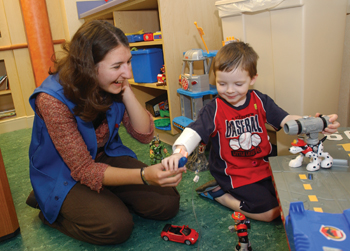
Eighteen-year-old volunteer Marie Brault plays with 4-year-old Hamer Goolsby in one of the many patient playrooms at the Monroe Carell Jr. Children’s Hospital at Vanderbilt.
photo by Dana Johnson
‘Patching’ works for teen eyes also: study
For decades, vision specialists believed that a condition called amblyopia, or “lazy eye,” must be treated before a child turns 7 years of age to be successful. But a new study, involving researchers at the Monroe Carell Jr. Children's Hospital at Vanderbilt, finds it's not too late for older children.
The nationwide study, headed up locally by Sean Donahue, M.D., Ph.D., Chief of Pediatric Ophthalmology at Children's Hospital, found that patching the strong eye to allow the weaker eye to “catch up” can work even well into the teen years.
“When I took my son to a doctor in our home town, he just prescribed glasses and said that after the age of 6 there wasn't anything else we could do,” said April Rose, mother of 11-year-old Brandon, whose lazy eye was not apparent until he began school and noticed he had difficulty reading.
Amblyopia is a leading cause of vision impairment in children and usually begins in infancy or childhood. One eye is impaired by a condition like crossed or wandering eye (strabismus), or vision problems like astigmatism, farsightedness, or nearsightedness. As a result, the vision center of the brain develops unevenly, ultimately leaving the weaker eye permanently impaired. It's estimated that 2.2 million children are affected by amblyopia, and researchers say only half of them have the condition properly identified and treated.
“Unfortunately, Brandon is typical for a patient with amblyopia,” said Donahue. “Probably 30 or 40 percent of amblyopia patients don't have a visible misalignment, but they fail vision screening in first grade, when we traditionally thought it was too late to patch.”
Donahue said he wasn't surprised when the National Eye Institute (NEI), part of the National Institutes of Health (NIH), funded a nationwide study to find out if, indeed, children ages 7 to 17 might benefit from treatment.
“There had been several reports that patching appeared to be successful up to age 9 or 10,” Donahue said. “What was surprising was that the patching helped many children up to age 17. That suggests the brain is more malleable at a later age than we thought.”
Donahue enrolled six children in the NEI study in which half were given the standard treatment of prescription glasses, while the other half used a patch over the strong eye to “work” the weaker eye 2 to 6 hours a day. A total of 507 children ages 7 to 17 were enrolled nationwide. The Tennessee Lion's Eye Center was one of two participating vision centers in Tennessee.
The results, which appear in the April issue of Archives of Ophthalmology, found more than half of the older children who got the patching treatment improved their vision significantly, while 20 percent of the children with glasses improved their vision.
“This is big for parents,” Donahue said. “This demonstrates conclusively that it is a good idea to bring older children with amblyopia in for evaluation of treatment.”
Brandon Rose did not take part in the official study. It was luck that brought him to Donahue's office after the enrollment phase was over. Brandon's younger brother, Ty, was five and had shown signs of lazy eye as well.
“While we were there for Ty, I asked Dr. Donahue if there was anything that could be done for Brandon,” Rose said. Donahue recommended patching at night and use of a “chemical” patch during the day. After just two months of using eye drops that blurred the vision of his strong eye, Brandon's eyesight has gone from 20/70, to 20/25.
Rose says both boys are doing very well and she is grateful. She has an older brother who also had a lazy eye and never received treatment.
“He's basically blind in one eye and you worry what would happen if that eye was ever injured,” Rose said. “I know my boys will be glad we found this treatment that's working for both of them.”













